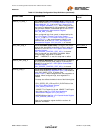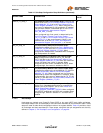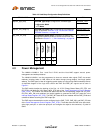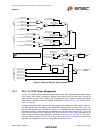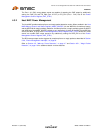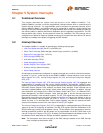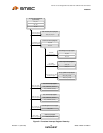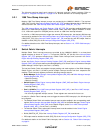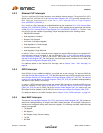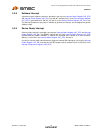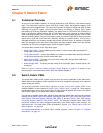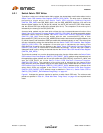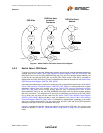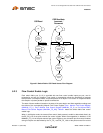
Two Port 10/100 Managed Ethernet Switch with 16-Bit Non-PCI CPU Interface
Datasheet
SMSC LAN9311/LAN9311i 51 Revision 1.4 (08-19-08)
DATASHEET
The following sections detail each category of interrupts and their related registers. Refer to
Chapter 14, "Register Descriptions," on page 167 for bit-level definitions of all interrupt registers.
5.2.1 1588 Time Stamp Interrupts
Multiple 1588 Time Stamp interrupt sources are provided by the LAN9311/LAN9311i. The top-level
1588_EVNT (bit 29) of the Interrupt Status Register (INT_STS) provides indication that a 1588 interrupt
event occurred in the 1588 Interrupt Status and Enable Register (1588_INT_STS_EN).
The 1588 Interrupt Status and Enable Register (1588_INT_STS_EN) provides enabling/disabling and
status of all 1588 interrupt conditions. These include TX/RX 1588 clock capture indication on Ports
2,1,0, 1588 clock capture for GPIO[8:9] events, as well as 1588 timer interrupt indication.
In order for a 1588 interrupt event to trigger the external IRQ interrupt pin, the desired 1588 interrupt
event must be enabled in the 1588 Interrupt Status and Enable Register (1588_INT_STS_EN), bit 29
(1588_EVNT_EN) of the Interrupt Enable Register (INT_EN) must be set, and IRQ output must be
enabled via bit 8 (IRQ_EN) of the Interrupt Configuration Register (IRQ_CFG).
For additional details on the 1588 Time Stamp interrupts, refer to Section 11.6, "IEEE 1588 Interrupts,"
on page 161.
5.2.2 Switch Fabric Interrupts
Multiple Switch Fabric interrupt sources are provided by the LAN9311/LAN9311i in a three-tiered
register structure as shown in Figure 5.1. The top-level SWITCH_INT (bit 28) of the Interrupt Status
Register (INT_STS) provides indication that a Switch Fabric interrupt event occurred in the Switch
Engine Interrupt Pending Register (SWE_IPR).
In turn, the Switch Engine Interrupt Pending Register (SWE_IPR) and Switch Engine Interrupt Mask
Register (SWE_IMR) provide status and enabling/disabling of all Switch Fabric sub-modules interrupts
(Buffer Manager, Switch Engine, and Port 2,1,0 MACs).
The low-level Switch Fabric sub-module interrupt pending and mask registers of the Buffer Manager,
Switch Engine, and Port 2,1,0 MACs provide multiple interrupt sources from their respective sub-
modules. These low-level registers provide the following interrupt sources:
Buffer Manager (Buffer Manager Interrupt Mask Register (BM_IMR) and Buffer Manager Interrupt
Pending Register (BM_IPR))
—Status B Pending
—Status A Pending
Switch Engine (Switch Engine Interrupt Mask Register (SWE_IMR) and Switch Engine Interrupt
Pending Register (SWE_IPR))
—Interrupt Pending
Port 2,1,0 MACs (Port x MAC Interrupt Mask Register (MAC_IMR_x) and Port x MAC Interrupt
Pending Register (MAC_IPR_x))
—No currently supported interrupt sources. These registers are reserved for future use.
In order for a Switch Fabric interrupt event to trigger the external IRQ interrupt pin, the following must
be configured:
The desired Switch Fabric sub-module interrupt event must be enabled in the corresponding mask
register (Buffer Manager Interrupt Mask Register (BM_IMR) for the Buffer Manager, Switch Engine
Interrupt Mask Register (SWE_IMR) for the Switch Engine, and/or Port x MAC Interrupt Mask
Register (MAC_IMR_x) for the Port 2,1,0 MACs)
The desired Switch Fabric sub-module interrupt event must be enabled in the Switch Engine
Interrupt Mask Register (SWE_IMR)
Bit 28 (SWITCH_INT_EN) of the Interrupt Enable Register (INT_EN) must be set
IRQ output must be enabled via bit 8 (IRQ_EN) of the Interrupt Configuration Register (IRQ_CFG)
For additional details on the Switch Fabric interrupts, refer to Section 6.6, "Switch Fabric Interrupts,"
on page 81.



